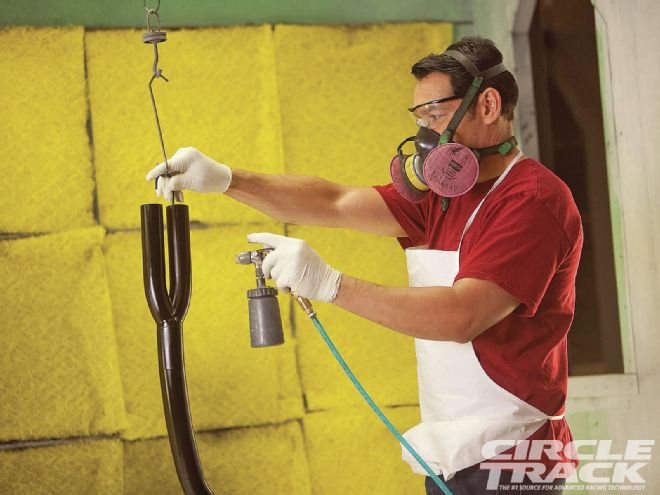
"General, we can rebuild him. We have the technology."
If you can remember that famous line, then you probably watched a lot of episodes from the television show The Six Million Dollar Man. Of course, that show went off the air more than 30 years ago, so if you're old enough to remember it you may not want to admit it.
In case you don't know that show, it was all about how the government created the first bionic human being and used him as a weapon to fight crime. We don't have anything to do with that here at Circle Track, but we are all about using technology to make our lives better when it comes to racing.
High-tech coating processes are one area that is definitely allowing us to make existing parts better. Of course, this is nothing really new. Forward-thinking engine builders and racing teams have been using coatings on everything from headers, to pistons, to floor panels for a while now. The question is, are you?
Dave Burton is an engineer with Jet-Hot High Performance Coatings and says that coatings are useful in the engine for reducing friction and directing heat where you want it. "We've had success putting a thermal barrier on the top of a piston," he says. "The coating that we use is a ceramic metallic coating that is excellent at resisting the heat of combustion. "It works because it has a reflective property. It actually reflects heat from combustion back into the combustion chamber itself. The coating also helps keep the heat more uniform throughout all the surfaces in the chamber. This helps eliminate hot spots. Now when the air/fuel mixture hits a surface in the chamber, including the piston top, it atomizes better and that is giving you a good, uniform fuel charge to burn and make power with."
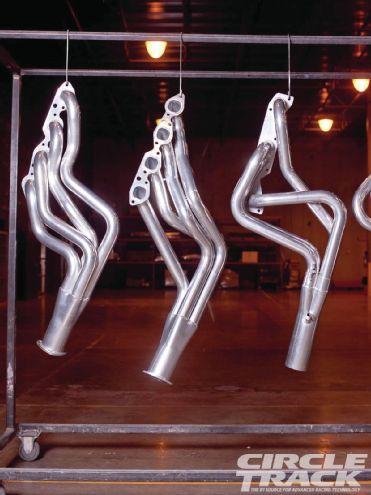 Because Jet-Hot’s header coating is only around 0.0025-inch thick, it can coat the flange to protect it as well without affecting the gasket’s ability to seal between the exhaust ports in the head and the flange.
Because Jet-Hot’s header coating is only around 0.0025-inch thick, it can coat the flange to protect it as well without affecting the gasket’s ability to seal between the exhaust ports in the head and the flange.
In addition, coating the piston skirts--the sides that rub against the cylinder walls--with a friction-fighting coating can improve both power and engine longevity. Different operations use coatings that may work differently. Jet-Hot, for example, uses an antifriction coating, called Slick Coat, that promotes lubricity on its own. Other antifriction coatings work by creating a surface that oil clings to, and the oil provides the lubricity.
Either way, an antifriction coating on the piston skirts can help prevent damage on cold starts after the oil has drained away from the cylinder walls and in the event your engine experiences a drop in oil pressure. The result is the coating not only protects the pistons, but also the crosshatch honing in the cylinder walls. This is important because keeping the crosshatch in good condition improves oil control and helps minimize blow-by. Plus, the antifriction coating can also help cut down on drag inside the engine, freeing up more power to be sent to the rear wheels.
"The valves also work a lot like the pistons," Burton adds. "You can achieve the same thing with a thermal barrier coating on the end of the valve and a friction fighter on the stems. That helps reflect heat into the chamber and the antifriction coating can help reduce the chances of a valve sticking in the guide.
"Valvesprings are also something that we ran across in testing that can be improved with a coating," he continues. "We did a test where we installed coated valvesprings on one bank of a Sprint Car engine and uncoated springs on the opposite bank. Then we went and raced the car. Afterward, we pulled the valvesprings and tested them. The coated valvesprings showed less loss of tension on the springs. That's neat because in circle track racing everybody is really trying to push the rpms, and that's really stressing the valvesprings. That coating was our Slick Coat product, and I think it helped because it allowed the oil to hit the spring and then move off and not cling to it. It pulled the heat away from the springs and that helped them live longer and work more dependably."
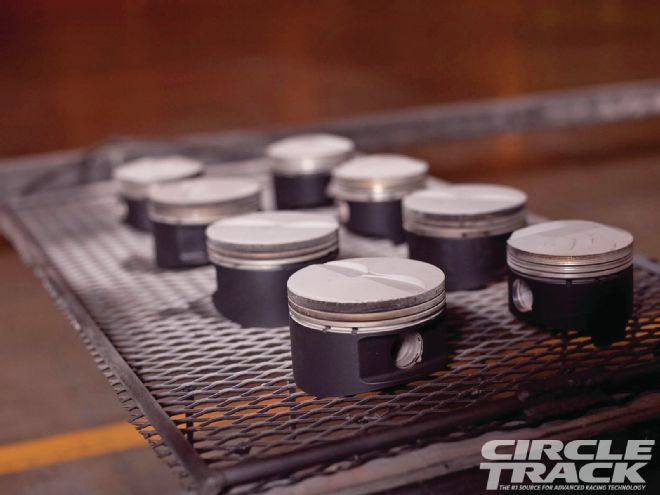 Coatings aren’t only for headers. These pistons have received a heat reflective coating to help keep the heat from ignition in the chamber for better flame travel. The skirts have also been given an antifriction coating to help prevent scuffing both the piston skirts and the cylinder walls in the event of a drop in oil pressure.
Coatings aren’t only for headers. These pistons have received a heat reflective coating to help keep the heat from ignition in the chamber for better flame travel. The skirts have also been given an antifriction coating to help prevent scuffing both the piston skirts and the cylinder walls in the event of a drop in oil pressure.
Of course, the application process for Jet-Hot's high temp coatings probably isn't something you would want to try for yourself anyway. "Our higher temperature coatings are what are called 'combustion sprayed coatings,'" Burton explains. "Those are metallic and ceramic blends or on the extreme high-temperature coatings, they are all ceramic. To apply the coating, it goes down through an oxyacetylene torch that heats up the particles so that they are actually melted while they are in the air before they strike the component to be coated. They then spread out and make a bond with the part itself. As you can imagine, it takes some very specialized equipment to achieve a proper bond with a combustion-sprayed coating, but for what it does, this type of coating is unmatched."
A heat-reflective coating helps keep exhaust heat inside the header tubes until it exits the exhaust system. This keeps the heat from radiating into the engine compartment which, in turn, lowers the temperature of the air entering the carburetor. Burton says the heat retained in the exhaust headers also lowers the overall pressure inside the exhaust system. This helps evacuate the burnt gasses from the higher pressure combustion chamber into the lower pressure exhaust ports and headers more efficiently.
Of course, header wraps do the same thing, and they are generally cheaper. But while a wrap can provide the same insulating properties as a coating, it can't provide the same protection from corrosion.
"From only a thermal standpoint, wraps do pretty good," Burton explains. "They are thicker than a coating, and any time you have more thickness it is easier to insulate against heat. But what a wrap doesn't do is provide any protection from the air and moisture that can still work its way down to the metal. You have not sealed the surface from water or air, and extreme heat cycling combined with the presence of air and water is what really damages exhaust parts. That's what causes the process of thermal oxidation. A coating, because it completely covers the metal, seals it off from both air and moisture and can provide the protection from rust and corrosion that a wrap can't.
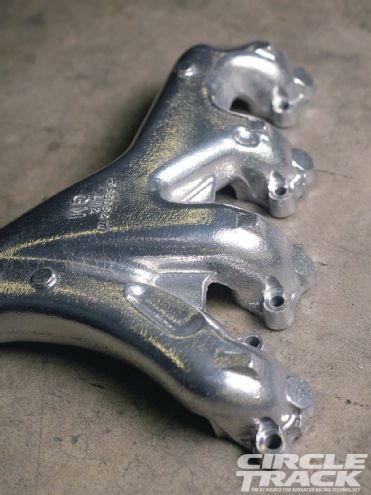 If you race a Pure Stock class that requires running the stock cast-iron exhaust logs, insulating coatings also work here, too. They can help keep the air inside the engine compartment cooler, which is important since that is the air that’s getting sucked into the carburetor.
If you race a Pure Stock class that requires running the stock cast-iron exhaust logs, insulating coatings also work here, too. They can help keep the air inside the engine compartment cooler, which is important since that is the air that’s getting sucked into the carburetor.
But Burton adds that sometimes a single coating can't cover every situation. Instead, Jet-Hot applies two different formulations in order to provide maximum protection. "At high temps you are getting thermal oxidation," he says, "where at lower temps you mainly need protection from chemical corrosion from salt, moisture, and things like that. The higher temperature coatings are more porous because they are more ceramic in nature and with the combustion spraying process the mixture isn't in a liquid slurry state before it is applied.
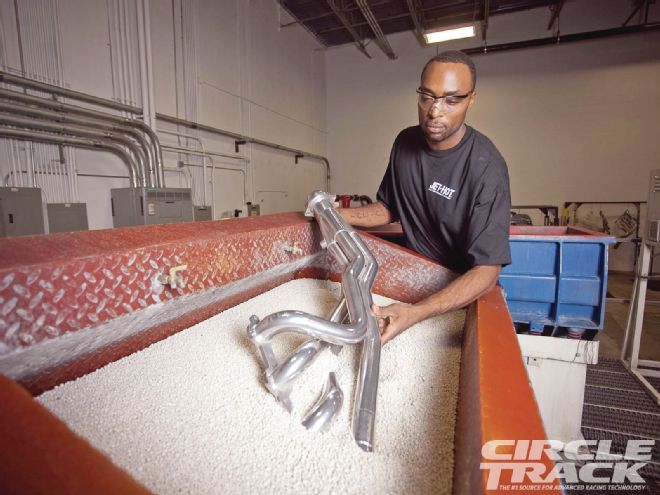 After the coated parts have finished curing, Jet-Hot uses a vibratory polisher that not only polishes the coating but also compacts the coating to make it both more durable and protective.
After the coated parts have finished curing, Jet-Hot uses a vibratory polisher that not only polishes the coating but also compacts the coating to make it both more durable and protective.
"So what we do with our high-temp applications is give that component a second coat. After applying the high temperature coating, we give it a top coat that's more impervious to moisture and chemicals. And we're also one of the only ones I know of that coat all the headers we do both inside and out. That process gives the headers the best protection possible."
Incidentally, Burton says Jet-Hot is able to coat used headers as well as new. Many assume that used headers can't be coated because the grain of the metal has been contaminated with oil, dirt, and rust. It's true that these types of contaminants can keep a coating from properly adhering to a set of headers, but Burton says that when the proper procedures are used to make sure these contaminants are removed from a set of used headers, the results can be just as good as what you normally see on virgin steel.
"No matter whether we are talking new or used," Burton says, "the process of preparing the headers before they are coated is critical. When the part comes in, the first thing we do is scribe an I.D. number on it on the flange or somewhere else where it won't be seen or cause a problem. That number goes into our system so that we can track the part into the future.
"After that we will clean the part, and then it will go into masking if there are any requirements there. The next step is blasting where we are getting rid of any oxides, residues, old paint, and basically just everything until we get down to clean, white metal. Then we clean the part again before we start the coating operation.
"And like I said, the headers don't have to be new. For the case of used headers we go through a little more work to clean them up, but no used parts have to come in here already blasted. We do everything here, and we basically have to in order to make sure the process doesn't go sideways. So you don't have to do it yourself because we're going to do it again anyway.
"Say, for example, someone has already shot blasted a set of used headers. They may look really good, but if they used steel shot, that's imparted small amounts of iron into the surface that will then rust. And that will cause delamination of the coating down the road. Or if there are still oil contaminants left on the headers, that can cause problems because we are working with water-borne coatings. As you can expect, the oil contaminants are going to separate from the mix and cause problems there as well. So if you have a pair of used headers, that's no problem. You can clean them up so that the dirt isn't falling off of them, but don't go to too much trouble because we're going to put them through the full process regardless. It's the only way that we are able to guarantee our customers are getting a top quality coating."
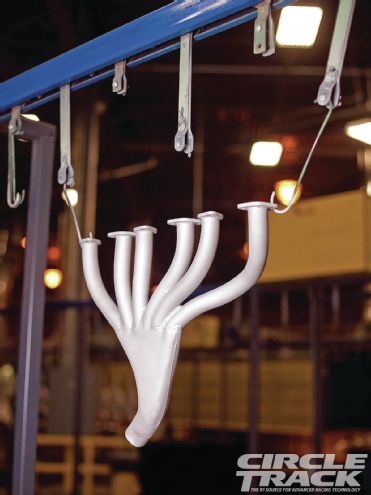 Headers must be protected from both thermal and chemical corrosion. Jet-Hot uses a base coat that’s a good insulator and also protects the metal from thermal oxidation. It is typically white. After the first coat has cured, it will go through the process again to receive a top coat designed to protect against moisture and chemical attacks.
Headers must be protected from both thermal and chemical corrosion. Jet-Hot uses a base coat that’s a good insulator and also protects the metal from thermal oxidation. It is typically white. After the first coat has cured, it will go through the process again to receive a top coat designed to protect against moisture and chemical attacks.
Burton suggests an easy test most racers can do themselves in addition to a thorough visual inspection. Use an ohm meter to check how conductive the coating is by placing your probes in two easily accessible areas approximately 12 inches apart. This reading is your baseline, because the coating is usually best in easy-to-reach areas of the part. Now place one of your probes in a seam, weld, or a more difficult to reach area of the part. The reading should be approximately the same. If it isn't, it's probably because the coating wasn't applied consistently across the part.
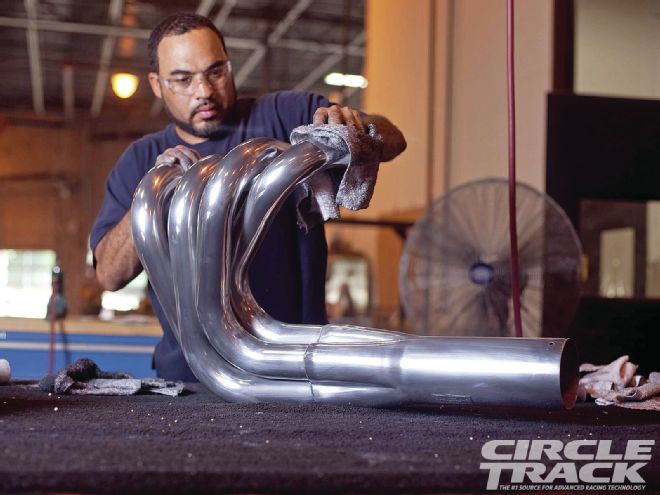 One of the final steps is hand polishing, which also allows every part to be visually inspected one more time before it goes out to the customer.
One of the final steps is hand polishing, which also allows every part to be visually inspected one more time before it goes out to the customer.
Now you can be sure your parts are coated well and go out and race with confidence.